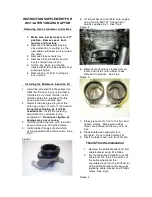
You need to know the area in which you are riding and what you and
your ATV can do in order to have a safe, enjoyable ride. Your riding areas
may not have the types of terrain discussed in this chapter, but it is still
wise to know the strategies to ride in them.
Reading the Terrain
Choose places in which you can ride safely. Stay on existing trails. Be
aware of terrain where you do not belong, like steeper slopes, impassable
swamps and other hazardous situations. Keep a watchful eye for sharp
bumps, holes, ruts, obstacles, wildlife, and other trail users.
Reading the terrain means to observe and understand the features and
characteristics of the land on which you are riding. This includes surface
composition, slope or camber of the trail, hills, rocks, tree stumps,
creeks, vegetation, fixed objects etc.
Learn to read the trail as you ride. A wise rider watches well ahead on
the trail. Know what is coming; be ready to react long before you get
there. Be constantly alert for hazards and changing terrain conditions.
Ride within your ability, not beyond your capabilities. Do not operate on
excessively rough, slippery or loose terrain until you have learned and
practiced the skills necessary to control your ATV on such terrain. Adjust
your speed to trail conditions and visibility. A responsible rider stays out
of trouble not simply by handling the machine well, but by riding safely
and avoiding risky situations in the first place.
Choosing Proper Speeds
Always look well ahead and choose a speed that is proper for the ter-
rain, visibility, operating conditions, and your experience.
By scanning far enough down the trail, you will be able to pick the best
“lines” (or safest path of travel) around or over hazards or small obsta-
cles. As you approach a hazard, do not fixate on it, but rather continue to
search for other clues in the environment and adjust speed well in
advance.
Using S.E.E.
There is an acronym to remind you of the procedures for scanning trails
and making riding decisions: “SEE”. Each letter in SEE refers to steps
needed to identify and respond to potential hazards in the lay of the land.
Consider the consequences of possible choices and respond with the
correct manoeuvring skill.
Scan
* Keep eyes moving and search the
terrain
* Check overall environment
* Watch several seconds ahead
* Avoid fixating on any one object
* Identify hazards
* Pick out specific problems
* Consider surface composition
* Other trail users and wildlife and
stationary objects
Evaluate
* Predict what may happen
* Think of consequences
* Consider riding techniques necessary
* Predict results of choices
* Decide what to do
- Slow down so there is time to react
- Pick the best line or path. Consider
traction, obstacles within skill level,
visibility
- Choose to reduce risk
- Choose to stay well within personal
limits and capabilities of your ATV
Execute your decision
* Adjust technique
* Adjust speed
* Adjust path of travel
Practising S.E.E.
An illustration of a rider’s thought process is described in this example.
In real-world ATV operation, the riding terrain constantly changes, requir-
ing a rider to continually process information and make decisions. The
following example shows how SEE can be used in this one “picture”. This
thought process must be seen as only a moment within a changing envi-
ronment.
How might a rider specifically use SEE? What might he or she think? A
snapshot entering a rider’s eyes and brain is shown here. Let’s eavesdrop
on the thinking strategy.
• SCAN. Open area with path of
travel along hill crest. Narrow,
dry path. Bumpy terrain, shrubs
and obstacles. Drop-off next to
trail’s path. Identify a narrow
trail along ridge. Steep drop-
offs on sides. Poor visibility
over crest. Dip in surface
ahead.
• EVALUATE. Predict what may
happen if other riders come
from the other direction result-
ing in a collision. Riders may be
coming from the sides. Getting
too close to the edge of the trail
could cause you to go over the
road side embankment. May
have to react quickly. Not much
escape area if trouble devel-
ops. Decide to slow, stay in
middle of trail. Look for
approaching riders. Stand up
for better visibility and adjust
weight if need for uneven ter-
rain. If path is clear, gain
momentum to get up next hill
area.
• EXECUTE. Release the throttle,
apply both brakes. Weight up
off seat - continuing to scan,
search and think.
Riding Strategies
14
Chapter 8
S
E
E












































